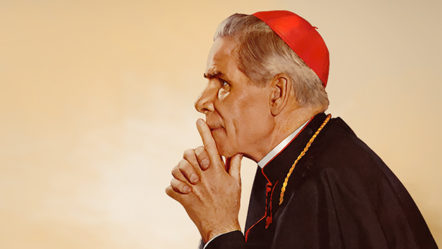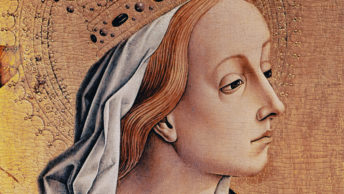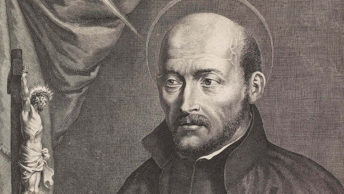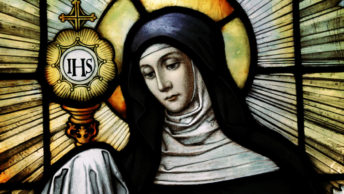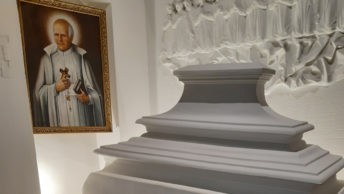Several years ago, after an evening Mass on All Saints Day, I made a suggestion to the celebrant that he might consider using the Baseball Hall of Fame in Cooperstown, New York as an analog to the canonization of saints. Just like professional baseball players, the best of the best, are enshrined in upstate New York. Similarly, our saints are the epitome of the best of humanity in their devotion to our Lord and their ability to love both their neighbors and enemies.
On May 22, 2021, Baseball celebrated reserve catcher, Jose Godoy’s game debut as marking its 20,000 player. Since then, I estimate that another 100-150 new players have been added to their list of men who have appeared in at least one major league game during a regular season. This is over Baseball’s 247-year history. Of this number, to date only 269 players, have been enshrined, out of a global population pool of several million possible players.
In researching this subject, it has been my understanding that until the reign of Pope John Paul II there had been fewer than 500 canonized saints. He nearly doubled the number by canonizing 482 new saints during his 23-year papacy. Pope Benedict XVI added a modest number of just 45 saints while our current pope has canonized 893 saints so far. This number is exaggerated because the pontiff canonized 800 Italian martyrs simultaneously. This is out of a Catholic membership of billions of souls over its two millennia.
Many Catholic leaders remind us that it is virtually impossible to calculate how many saints there really are because by definition all the souls in Heaven are saints. To put this in its proper perspective, demographic experts estimate that approximately 100 billion people have inhabited the earth during the last 2,000 years.
I know the Church has tried to broaden its appeal to the world. Since it is a universal church, it needs more role models who lived saintly lives in Catholic history. The Church now feels that these role models should include many outside the traditional confines of the Western world. It is also true of Baseball’s need for a Hall of Fame with more diverse players.
Recent popes have not only expanded The College of Cardinals but have replaced several Italian Cardinals by attrition with bishops from Asia, Africa and Latin America to give a better picture of its universal mark. I sometimes wonder what this has done to the faith of millions of traditionalists. My concerns have been expressed already in my essay, Two Churches, published on these pages in 2017.
Most would agree that this Church expansion dates back to the papacy of John XXII and Vatican II. In reading George Weigel’s recent book, To Sanctify the World, I was amazed at the broad scope and range of the many changes that had been instituted. I am not quite sure that all have been as beneficial as the optimistic author infers.
My basic impression of the Council, which took place during my college years, rests on the fact that the Church has been trying to engage modernism since the turn of the late 20th century. I think it failed then and all one needs to do is read a newspaper today to realize the world is no closer to sanctification. I think Weigel’s optimism springs from the utopian thinking of theologian Jaques Maritain, who had a profound influence on the Council.
All this provides context for the expansion of the number of canonized saints. I think it is more than coincidental that three of the four major players at the Council included one reigning pope and three future popes. The fact three of them were all canonized in a span of a mere four years stands out as a serious anomaly in church history. It makes me wonder about the nature of any official investigations of these prelates for exemplary sanctity and devotion.
Both the Catholic Hall of Fame and the Baseball Hall of Fame are open to similar criticism. When people have experienced a special religious figure or baseball player in person, reason can sometimes be clouded by personal bias. As every baseball fan has his favorites, so does the Catholic faithful. I think Bishop Fulton J. Sheen deserves canonization more than any of the aforementioned popes. My judgment is not based on serious research but on having personally experienced his electrifying personality in his many books and his popular TV program, Life is Worth Living. More importantly, I attended his three-hour devotion on a Good Friday at my parish church in Forest Hills, Queens many years ago.
As for Baseball I felt the same about Pee Wee Rese. There are many who say he was inducted, mainly because he played in Brooklyn, one of the most popular teams in the game’s history. Could not this sort of personal feeling or bias have been at work in the three popes elevation to sainthood as well? In other cases, I think the odor of politics prevails more than the scent of incense.
Like their religious counterparts, baseball fans believe it is the ultimate honor to be enshrined in Cooperstown while Catholics revere the saints for similar reasons. But most of us want the judgments of the electors to be fair, unbiased and based on their actions on the field of play or in an environment plagued by the world, the flesh and the devil.
Baseball examines its candidates on many categories. After the mandatory wait of five years, for the next 10 years, the Baseball Writers Association scrutinizes all its candidates. The Church also has a special office, the Dicastery for the Causes of the Saints, to vet its candidates. Within it, there is a position known as the advocatus diaboli (Latin for Devil’s advocate or DA). Not to be confused with the Al Pacino film, the Devil’s Advocate,* the Church position of the same name has been in existence since the 16th century when Pope Leo X is alleged to have introduced it. It was formerly adopted by Pope Sixtus V in 1587. Its purpose is to provide a critical analysis of the lives of those proposed for sainthood so as to determine if the candidates are worthy of canonization.
The Devil’s Advocate has much in common with the BWA. While the latter focused mainly on playing and leadership talents, the DA is meant to expose any serious character flaws or misrepresentations of heroic sanctity in the lives of its candidates. The position usually goes to a canon lawyer. It is my understanding that more than a few generations should pass before beginning consideration so as to leave out the possibility of a selection being based on popularity or other personal biases.
As a high school student, I read the novel, The Devil’s Advocate, written by Morris West. It is the story of an aging priest with terminal cancer. As for his final task on earth, the pope has given him the job of investigating a candidate for sainthood, a popular local figure, named Giacomo Nerone from the village of Calabria. Many of the towns people were promoting his candidacy because his sainthood will bring prosperity and notoriety to their poor town.
Father Meredith, the Devil’s Advocate, learns that Nerone was far less than saintly. He was a deserter from the British army during the war, had an illegitimate son by a local woman, and was executed by Communist partisans in 1945. Despite all this, he had a cult following in his village. After meeting the son and several others, Father Meredith struggles to learn the truth about the alleged saint, fulfill his final duties for the Church and come to terms with his own mortality and challenged religious faith. The book dramatically portrayed the complexities and importance of the office.
In 1983, Pope John Paul II reduced the Devil’s Advocate to a vestigial status. He did this because it was alleged to have held up the candidacy of several favored people. As a result, the road to sainthood became a virtual open highway to official sainthood. To illustrate this, one need to look to the wit and wisdom of Mother Teresa, who was canonized in 2016, 19 years after her death. (It is my opinion she should have been canonized long ahead of the two Johns.) A young nun once asked her how she could become a saint. Mother Teresa said, Just live long enough because the pope is canonizing almost everyone.
The flaw in John Paul II’s decision to eliminate the DA is that the lack of vetting might allow some candidates unworthy of canonization. Many baseball fans have chided MLB’s addition of Veterans Committees to increase the number of members not elected by the writers. Catholic and baseball purists argue that such changes tend to water-down the process for special recognition.
Of the 266 popes since St. Peter, 81 have been declared saints. Of the first 53 saints, 52 had been pope with most of them being martyred. There have been only nine canonized popes in the last 1000 years. This discrepancy appeared due to the uncertain and persecuted times of the Church’s first 300 years before Constantine gave it official recognition.
As for the trio of popes canonized by Pope Francis, the two Johns were so proclaimed in 2014. Four years later Paul VI received the saintly honor. Many critics immediately labeled this the rush to sainthood. John XXIII had to wait 50 years after his death in 1978. John Paul II was canonized after just nine years while Paul VI had to wait 40 years. Of all the canonized saints in Church history, the average wait time between death and official sainthood has been 187 years.
I wonder why the hurry, especially with John Paul II. Since all humans share the same flawed nature, it is not farfetched to believe that motives, other than pure faith were at work. Canonizations are a call for worldwide celebrations, festivities and good times. Some might say they are good for public relations and help people forget the more salient problems in Church governance.
The Church has implied that to achieve a greater need, the rules of vetting must be rushed or waived completely. John XXIII was selected because of his innovative and revolutionary call for aggiornamento in the Church. The pope wanted to open the church windows and let the stale air out but as his successor later said, open windows can also let in the smoke of Satan. Considering some of the details in Weigel’s aforementioned book, several agenda items, such as education, priestly formation and the family can be judged as failures.
The faith does not seem to be taught properly, even in our Catholic schools, as polls show that only a third of Catholics understand or believe in Jesus’ Real Presence in the consecrated Eucharist. Catholic marriages seem to end in divorce as often as any other marriage. Priestly vocations are down, many elderly priests have died or retired and the priesthood has to rely on priests from foreign countries and its diaconate to function properly.
John Paul was a man known for his personal virtue and public charm. Most of his peers knew him as a man of extreme holiness. I doubt if anyone could dispute this but we will never know because there was no Devil Advocate to raise these questions. The lack of one, however, has surprisingly not prevented many from pointing out his failure to manage the greatest crisis in the history of the Catholic Church.
Many cite the pontiff’s firm support of Mexican priest and known pederast, Marcial Marciel Degollado, who founded the Legion of Christ. The latter was accused of abusing several young boys and fathering a number of his own children. The Pope’s apologists said he should not be denied sainthood because of a managerial error. This euphemism should sound insulting to the parents of the boys he abused on the pope’s watch. If more time had been spent and Pope John II had been fully vetted, perhaps his canonization would have been postponed for a time when a less biased understanding had evolved.
Then there is the case of Pope Paul VI. Sexual accusations against him date back years before he became pope. By the time he was proposed for sainthood, these accusations had been public knowledge. There is a lengthy article floating around the Internet, written by traditionalist Dr. Marian Horvat. She quotes a number of respected journalists who name names, including a famous red-haired actor, as well as details and locations, in Milan and Rome. Were the Devil Advocate still existent—John Paul eliminated it five years after Pope Paul’s death–I believe these charges would have been fully vetted and the truth of the matter publicly revealed. I seriously doubt we will ever know the real truth.
Baseball has had somewhat similar problems, as a significant number of its early stars have had been guilty of many serious character flaws, such as alcoholism, sexual promiscuity and racial bias. But the comparisons end here because one is on a purely human level while the other involves the integrity of the Universal Church.
I think it is impossible to fairly judge a human being, especially a pontiff. But for civilization to continue we often must. I have known people in my life who will never be recognized as saints by the Church but whom I have watched struggle with illnesses, mental and physical. Others have given in to serious temptations and even descended into dark places where some never come out alive. I have little doubt that some of them are enjoying the Beatific Vision as I write. While I long gave up the hope of playing professional baseball, my longing for at least a spot in the cheap seats of the Catholic Hall of Fame gallery gets stronger each day.
*In the film, Pacino plays, not only the Devil’s lawyer but Satan himself whose goal is to use his illegitimate son, also a lawyer, to turn souls away from his Divine Enemy.

